How to properly plant pomegranates at home: a beginner's guide
Not every gardener has the opportunity to plant a pomegranate in a garden plot. However, with due diligence, you can grow this fruit at home. How to get material for planting, what conditions are important to observe and what to do after receiving a sprout, we will tell in this article.
The content of the article
Is it possible to grow pomegranate at home
In any house or apartment, you can plant and grow pomegranate... To do this, you only need a window sill, a pot and planting material. The indoor pomegranate tree is compact, blooms very beautifully and even gives small pot-bellied fruits.
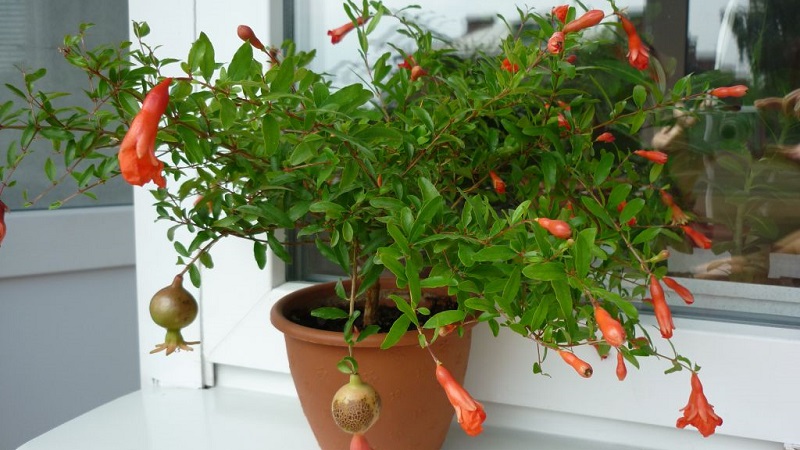
How to get planting material
There are 2 most popular options: Buy seeds from a specialty store or germinate yourself.
Shop seeds allow for hybrid forms of dwarf pomegranate. About 500 varieties are known, most of which are suitable for home breeding.
Benefits:
- You can get a strong tree 100-120 cm high.
- Pomegranate does not shed foliage during the cold season and retains its decorative effect.
- It gives the first fruits in 2-3 years after planting the seeds.
However, you should not dream of large and juicy fruits. Even trees that have received by grafting from a fertile parent, capable of producing fruits only 3-5 cm in diameter... Although they are pleasant to the taste, they have a distinct sourness.
A plant from a seed very rarely inherits the qualities of the parent tree... To get a strong and fruitful pomegranate, it is better to propagate it vegetatively.
If you decide to sprout your own seeds, choose a large, bright raspberry fruit... It should not have external damage and signs of rot. A fruit with hard bones, smooth, whitish with a slight creamy sheen is best suited. Green and soft seeds are not good.
Training
Before planting seeds, it is necessary to carry out simple preliminary procedures.that will increase your chances of success.
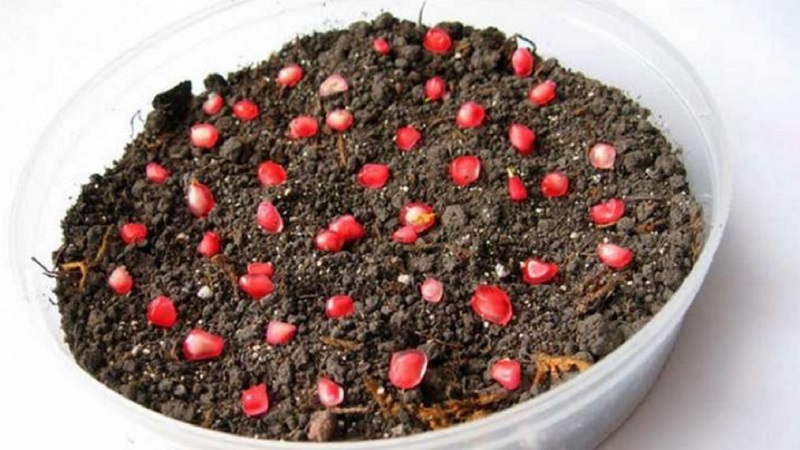
The soil
The following soil types are suitable for pomegranate:
- Universal or peat soil for citrus fruits, roses, begonias.
- Overripe leaves, sand, humus - 2: 1: 1.
- Sod land, peat, sand - 1: 1: 1.
- Peat, coarse sand - 1: 1.
- Fertile soil, compost - 2: 1.
- Humus, fertile soil, wood chips, river sand, peat - 1: 2: 0.5: 0.5.
The result is a moderately nutritious and crumbly soil. In such conditions, pomegranate pleases with lush foliage and good flowering. In any of the options, you can add a little wood ash for decontamination. Before planting, be sure to steam the soil.
Capacity
To plant a pomegranate, you will need a disposable container with water holes... In the future, a plastic or clay pot of 100-200 ml will do.
Reference. In a tight container, pomegranate grows better, and its flowering becomes abundant.
Seeds
Before planting, the selected grains are immersed in water for 2-3 hours, and then washed under running water, cleaning with your fingers from the remnants of the pulp. There is also an alternative option: the seeds are wrapped in several layers of gauze and carefully squeezed out, and then washed under running water.
Reference. Germination rates of pomegranate seeds vary from 45% to 95%. If you plan on getting just one tree, plant at least 10 seeds to get 3-4 sprouts.Among them, you will choose the most beautiful and strongest.
After washing, an initial check is carried out for the quality of the seeds. To do this, you need a saline solution - 1 tsp. for 1 st. water. Good, full-bodied seeds in this solution will drown, and empty ones will float to the surface. They are thrown away immediately.
The next step is to soak clean seeds in any stimulant available.... These can be special preparations ("Epin", "Zircon", "Immunocytofit") or folk remedies (aloe juice, wood ash).
Seeds are half filled with nutrient mixture... However, experienced gardeners advise spreading the seeds between cotton pads soaked in stimulating moisture. They are left in this form for 10-12 hours.
There are two simple ways to increase the germination rate to 90-95%:
- Scarification is a small mechanical damage to the hard shell of the seed. A few tiny grooves are made with a nail file, and then gently punctured the seed with a fine needle. It is important not to damage the germ in the grain.
- Stratification - cold exposure of seeds. Pomegranate seeds are dipped in wet sand and placed on the bottom shelf of the refrigerator. This hardening lasts 3-4 months, the optimum temperature is 0 ... + 2 ° C.
Place of cultivation
Allocate space for the pomegranate tree on a well-lit windowsill.... The south or southeast side is best suited. Remove all spreading neighbors - their shadow will oppress the young pomegranate.
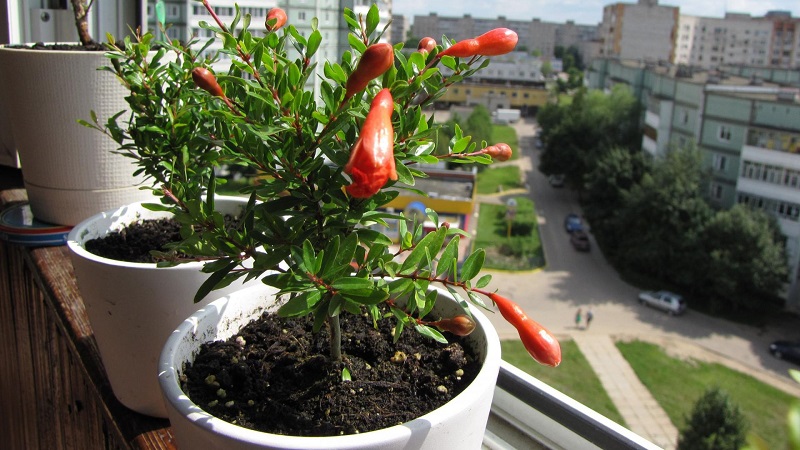
How to plant a pomegranate at home
Planting seeds is best in November or mid-spring.... To begin with, the selected grains are placed in disposable containers up to 8-10 cm deep, keeping a distance of 2-3 cm.
Important! The container must have holes for water drainage.
Drainage is poured at the bottom of the container. It can be pebbles, branches or sticks, broken brick, small rubble. The drain should take up 1/4 of the capacity.
You cannot bury seeds in the ground, it is best to press them a little into the ground with a pencil or stick. Each seed is immersed 1 cm.
Cover the container with foil or glass to create a greenhouse effect so that moisture does not evaporate too quickly. After the container is placed in a warm place with a temperature of at least + 25 ° C.
The soil is moistened as it dries with a spray... You cannot pour much water - the seeds will rot or go to a depth and cannot germinate. Immediately after the formation of the first shoots, the container is transferred to the windowsill. The temperature should be kept at a maximum of + 18 ° C to avoid excessive stretching of the sprouts.
There is no need to immediately remove the bag or glass. The plant is gradually accustomed to dry room air. within 3-5 days. After that, the seedlings are transferred to the usual growing mode.
Interesting on the site:
How to care for a young sprout
Small sprouts need temperatures between +18 and + 25 ° C and lighting for 10-12 hours a day.
If the landing was carried out in the fall, plants need illumination with special phytolamps. The minimum working time is 2 hours in the morning and in the evening. In winter, the sprouts are illuminated constantly throughout the day.
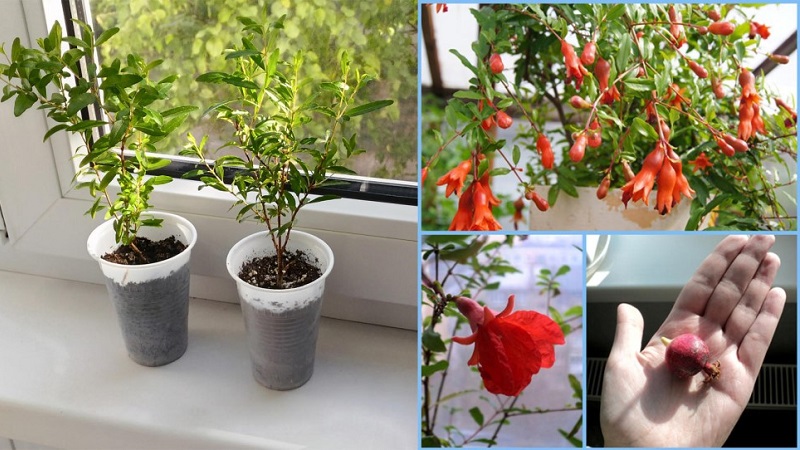
Pomegranate needs moderately humid air... The heat from the battery can destroy young plants, so they put bowls of water next to the container, use a humidifier, or sometimes spray the sprouts from a spray bottle.
Water it as needed: ideally - when the soil dries up to a depth of 2-3 cm.
Sprouts are distributed in a separate pot after 2-3 leaves appear on them... Use the same soil as when planting the seeds. At the same moment, the sprout is pinched so that the roots get stronger and develop better.
Reference. After transplanting, it is better to place the pot under diffused light for one week, and then return it to the native windowsill.
It is believed that pinching is best done one month after transplant... This stimulates the rapid development of new branches and makes the crown round.
How to propagate a plant
To propagate the pomegranate tree several ways available.
Underwire
You can plant grains not only of a purchased pomegranate, but also of fruits obtained from a house tree... To do this, choose the largest pomegranate, without visible signs of damage, traces of diseases or pests, and then follow the algorithm described above.
Cuttings
Healthy, strong one- or two-year-old shoots are taken from an adult plant.... They take root well and are able to form a powerful root system and a beautiful crown. Cuttings are carried out in late February - early March.
The optimal length of the planting material is 20-25 cm, on each cuttings there are at least 6 buds. There should be no traces of diseases, pests or mechanical damage on the handle.
Before planting, the cuttings are placed in a small glass container with water., in which 1 tablet of activated carbon was dissolved. Next, the dishes are placed in a well-lit place for 2 weeks - this is how long it will take for the roots to develop.
Next, the cutting is planted in a prepared pot and placed on the windowsill.avoiding direct sunlight. The tree is transplanted to a permanent place at the end of summer.
This the method is considered the most effective... It allows you to get an adult pomegranate tree after 2 years.
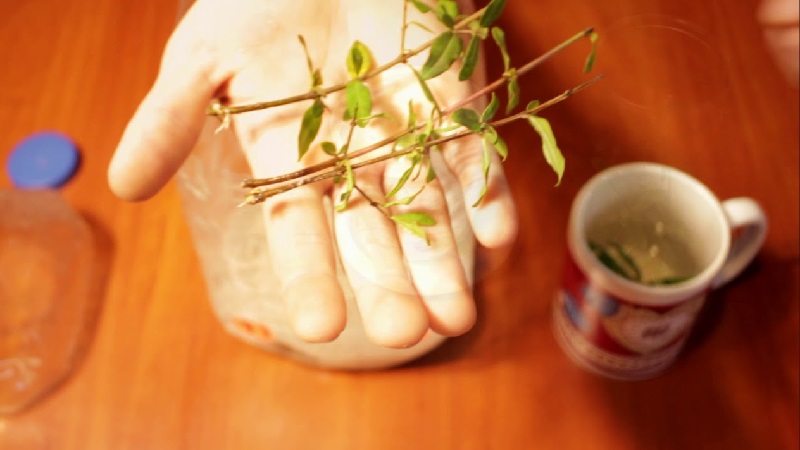
Layers
For this method, choose a healthy, strong twig... Without separating from the parent tree, it is surrounded by a plastic pot with drainage holes, which is filled with a suitable soil. Cut off the layers after complete formation of the roots.
Grab
Vaccination is organized in 3 ways: by budding (dormant eye), under the bark or into splitting (splitting the cutting). Budding is carried out in September, the remaining 2 are used in early spring. For the scion, a stalk from a young shoot is used, its optimal length is up to 20 cm. The stalk is placed on the north side of the tree to avoid direct sunlight.
Sprouts
For such reproduction, root shoots are used.... For this, biennial strong sprouts are chosen in September. Having carefully detached from the mother tree (it is important not to damage the root system), the sprout is moved into a cramped pot with suitable soil and placed in a bright place for several days, avoiding direct sunlight.
Within 2-3 weeks the seedlings will take root and can be transplanted into larger pots.
How to transplant
Mature pomegranates are best replanted in late summer.... Larger pots are used, the ground in them is previously disinfected. This also applies to purchased soil. It is impossible to crush the roots strongly, there must be room for the further development of the root system.
The first time after transplanting pomegranates are kept in a slightly shaded place.... After a week, the pot is returned to a well-lit windowsill.
Conclusion
Grow a pomegranate tree not difficult at all. Having obtained a plant from seeds, in the future, you can improve its characteristics by propagating by cuttings. The pomegranate tree on the windowsill will not only delight you with lush foliage and abundant flowering, but also give a small harvest.